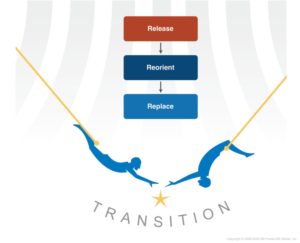Recognizing transition phase opportunities can help you and your team take the leap into Newland
In Part 3, we explore the benefits of transition and consider the risks. Using our trapeze artist illustration we introduced in Part 1, our transition begins the moment we let go of the last vestiges of Oldland and reach out a hand to grasp Newland and feel in that moment a bit of fear, uncertainty, or terror. Do we remain in a state of limbo or thrust forward and take that leap of faith into Newland?

The most disorienting thing about transition is that it begins with an end and ends with a beginning! It helps to have a keen awareness of what is going on and why a successful transition requires a specific strategy. Although there may be a feeling of adventure or excitement in transition, there are also undercurrents of anxiety or fear.
Transition is much like a rite of passage—you need to experience it to earn the right to enter Newland. This experience includes opportunities or benefits along with dangers or threats.
What benefits or opportunities does transition provide? Transition is the best time to . . .
- Make major changes during the discomfort before you settle into Newland.
- Identify influential leaders, as real leaders tend to surface during the trauma of transition. Now is the ideal opportunity to identify the next generation of leaders who will be needed in Newland.
- Maximize creativity and innovation. In transition, the group must think creatively and develop innovative ways of spreading the vision, strategizing, and solving problems. They are in lateral thinking mode. So, tackle new challenges and take advantage of the creative energy.
- Refocus on the vision. It is easy to lose sight of the vision during the journey and become caught up with minor problems. At this point, the vision needs to be revisited and reinforced before you cross the border into Newland. Hold people accountable for aligning with priorities.
- Reorganize structure and people. When the group reaches transition, it may be apparent that previous plans for the border crossing won’t work. Now is the time to rethink those plans.
Confront or replace those resisting the change. Even at this late point, some people who like to control and resist are adamant that they do not want to change. Have the courage to confront them with an ultimatum–or remove them.
Downside of Transition
As with the upsides of transition, you will find more transformational change initiatives fail during a transition. Let’s think about why:
- The group has already been through visioning, strategizing, and navigating. When they reach transition, they relax, feel almost there, and begin to slide back to Oldland. They neither removed the anchor holding them to Oldland nor positioned it to pull them into Newland.
- Change fatigue. The group is tired. Navigating the terrain is hard work. Although you need to celebrate the arrival in Transition, if you relax there, you will slip back.
- Management sees that the group is beginning to resist the change and tries to push them through Transition. Pushing (not pulling) provokes an immediate negative reaction that can destroy the change initiative. Here you have to manage the chaos without micromanaging the people by focusing on pulling rather than pushing.
- The group thinks they have finished. They have made plan after plan, sat in endless strategy meetings, and now think: “We’ve done all the planning, so the work is finished.”
Transformational change initiatives can fail in transition for other reasons. Transition is an exciting yet dangerous place to be on your journey to Newland. We either release our dependence on Oldland or return to Oldland. All who embark on this journey must be aware of the common dangers to take the final complex steps into Newland…just know it is well worth it!
Copyright © J2N Global








